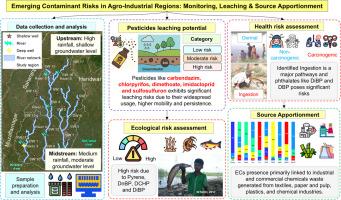集约化农工地区地表水和地下水中新出现的污染物:分布、风险和来源评估
IF 7.7
Q2 ENGINEERING, ENVIRONMENTAL
引用次数: 0
摘要
集约化种植和工业活动对新出现的污染物(ECs)构成了重大的水安全风险。本研究对印度欣顿河流域地表水和地下水中农药、多环芳烃(PAHs)和邻苯二甲酸酯(PAEs)进行了监测,以评估其空间分布、生态和人类健康风险以及来源评估。利用农药理化性质和区域水文地质性质评价了现用农药的淋滤潜力。值得注意的是,检测到的ECs与集约化农业和工业活动(部分)处理过的废水排放、河流污染、频繁洪水和地下水位下降有关。淋溶指标表明,毒死蜱、吡虫啉、阿特拉津、多菌灵和乐果等农药在甘蔗、水稻和小麦等强灌溉和地下水位较浅(~ 9 mbgl)的系统中广泛使用,淋溶风险最高。芘、蒽、邻苯二甲酸二丁酯(DnBP)、邻苯二甲酸二异丁酯(DiBP)和邻苯二甲酸二环己酯(DCHP)具有中高生态风险,特别是对藻类、水蚤和鱼类等水生生物。健康风险评估确定DiBP和DnBP是最关键的污染物,摄入的风险最高。来源分配分析确定了工业和商业化学应用和相关废水排放占主导地位的五个主要来源。PAEs的存在与纺织染色、造纸和纸浆、塑料成型以及化学工业中增塑剂、粘合剂和涂料的广泛使用有关。相比之下,多环芳烃的存在反映了化石燃料燃烧、砖窑操作、作物残茬露天燃烧和车辆交通。研究结果将有助于制定特定污染源的补救战略、保障公众和生态健康、确定潜在的补给地点和制定管理框架。本文章由计算机程序翻译,如有差异,请以英文原文为准。

Emerging contaminants in surface and groundwater of an intensive agro-industrial region: Distribution, risks, and sources assessment
Intensive cultivation and industrial activities pose significant risks to water security from emerging contaminants (ECs). This study monitored pesticides, polycyclic aromatic hydrocarbons (PAHs), and phthalates (PAEs) to assess spatial distribution, ecological and human health risks and source assessment in the surface and groundwater of Hindon River Basin, India. The leaching potential of currently used pesticides was also assessed using pesticide physicochemical and region hydrogeological properties. Notably, detected ECs are associated with (partially) treated wastewater discharge from intensive agriculture and industrial activities, polluted rivers, frequent flooding and declining groundwater levels. The leaching indices indicated that chlorpyrifos, imidacloprid, atrazine, carbendazim, and dimethoate pesticides posed the highest leaching risks due to their widespread application in sugarcane, rice and wheat systems with intense irrigation and shallow groundwater level (∼9 mbgl). The pyrene, anthracene, di-n-butyl phthalate (DnBP), diisobutyl phthalate (DiBP) and di-cyclohexyl phthalate (DCHP) posed moderate-high ecological risks, especially to aquatic organisms such as algae, daphnia, and fish. Health risk assessment identified DiBP and DnBP as the most critical contaminants, with ingestion posing the highest risk. The source apportionment analysis identified five major sources with industrial and commercial chemical applications and related wastewater discharges found as dominant. The presence of PAEs was linked to textile-dyeing, paper and pulp, plastic molding, and widespread use of plasticizers, adhesives and coatings in the chemical industries. In contrast, PAHs presence reflected fossil fuel combustion, brick kiln operations, crop residues open burning, and vehicular traffic. The study findings will help in developing source-specific remediation strategies, safeguarding public and ecological health, identifying potential recharge locations and developing a regulatory framework.
求助全文
通过发布文献求助,成功后即可免费获取论文全文。
去求助
来源期刊

Journal of hazardous materials advances
Environmental Engineering
CiteScore
4.80
自引率
0.00%
发文量
0
审稿时长
50 days
 求助内容:
求助内容: 应助结果提醒方式:
应助结果提醒方式:


